We’re dreaming of warm sun and sand between our toes and Boojum tree forests! Where else would we be but continuing on with our Baja RV adventure? In Part Two of this three-part post, we’re heading south from San Felipe to Bahia de los Angeles. Come along as we pack up the trailer and continue to wander down along Mexico’s Sea of Cortez.
Disclosure: This post contains affiliate links. If you buy something from one of our affiliates, we receive a small commission at no extra charge to you. Thanks for helping to keep our blog up and running!
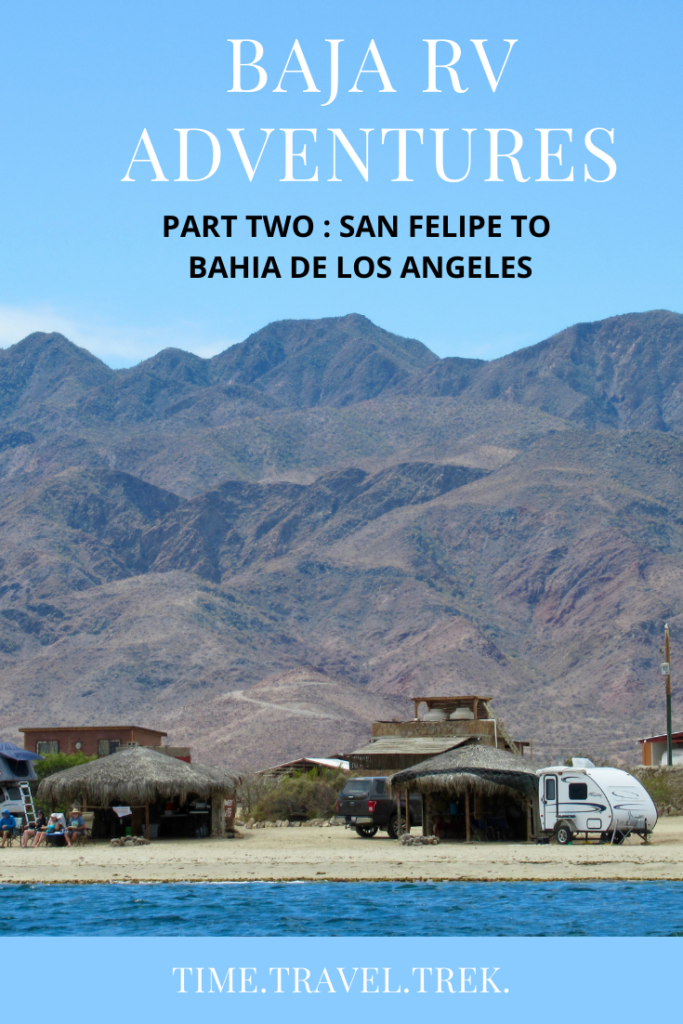
Table of Contents
On the Road Again
In Part One of this three-part post about RVing in Baja, we drove from the U.S./Mexican border to San Felipe. Today we are heading south on Highway 5 out of San Felipe, dodging potholes as best we can and momentarily doubting the wisdom of this adventure. Worries quickly dissipate as we hit the new pavement. There are wider shoulders. Traffic is light. Countless signs advertising campos mark random dirt roads snaking off the paved highway toward the sea. With Bahia de los Angeles set as our destination, we don’t have time to stop and investigate these roadside campsites on this trip. I make a note to do so on our next trip down.
As with the highway north of San Felipe, the highway south is sparsely populated with few towns. We pull into Puertocitas to have a quick look, but even the gas station is closed. No hay gas! There is no gas, so it is a good thing we fueled up in San Felipe before hitting the road. RV travel in Baja means planning ahead!
The only permanent military check stop on this leg of Highway 5 is just north of Bahia San Luis Gonzaga. Friendly soldiers peer into the truck box and trailer, ask us where we are coming from and where we are going before sending us on our way.
New Territory
Highway 5 from Bahia San Luis Gonzaga to the junction with Highway 1 is the newest section of road. It’s uncharted territory for us. Far from being the rough road that existed only a few years ago, the newly paved highway is a dream to drive. In my mind, this is where our Baja pours on the magic. The road leaves the coast and winds and climbs up through scattered boulder fields and into the land of elephant trees and boojums.
What the Heck is a Boojum?
A Boojum tree (Fouquieria columnaris) is a native flowering tree found only in the deserts of Baja California and a small region in Sonora, Mexico. Boojum refers to a strange and mythical creature in Lewis Carroll’s children’s book, The Hunting of the Snark. University of Arizona professor Godfrey Sykes found the plant in 1922. He is quoted as saying “ho, ho, a boojum, definitely a boojum!” The name stuck.
Reaching over 15 meters (50 feet) in height it looks more like an upside-down carrot than a tree. When Boojum trees bloom, they look like a burning candle. Because of this, it is also called Cirio which means candle in Spanish.
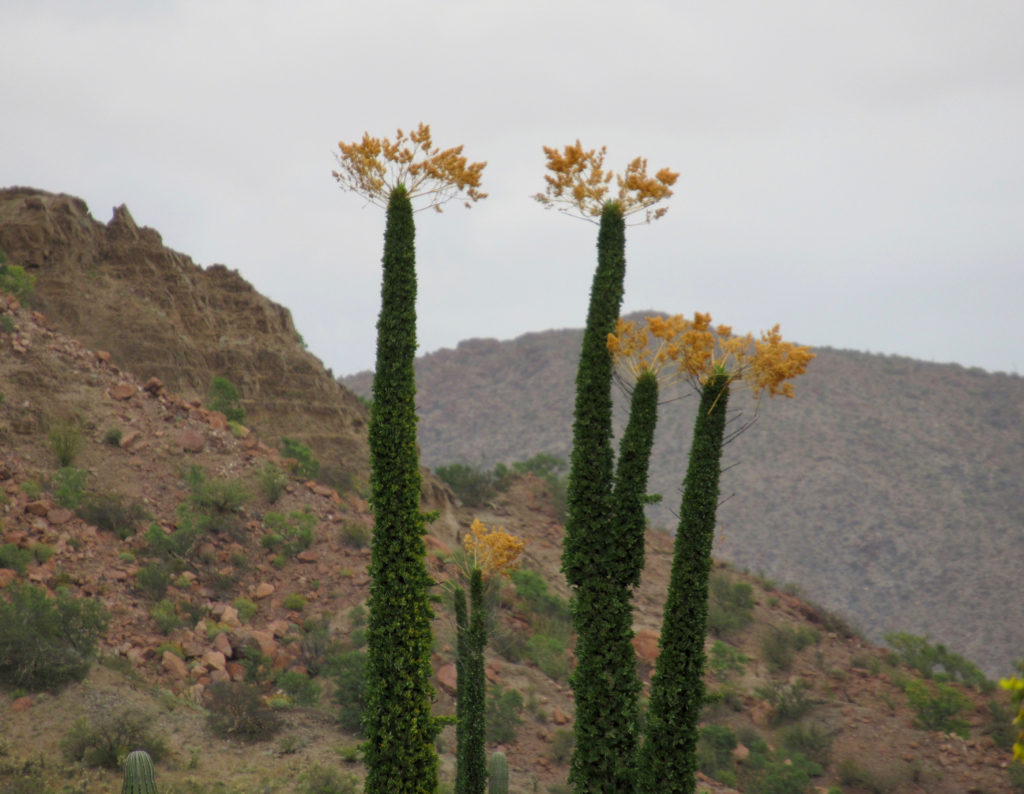
No matter what you call it, it is one of the strangest-looking plants on earth. Boojums are closely related to ocotillos. Like ocotillos, Boojum trees produce leaves only after it rains. The leaves fall off during drought in order to limit water loss.
Elephants in the Desert?
While its trunk might resemble a pachyderm leg, the Elephant tree is yet another bizarre Baja plant. Underneath the white, papery bark, thick tree trunks store water. Like Boojum trees, the drought-resistant plants lose their leaves to save themselves until it rains. Elephant trees are common in the drier desert regions of the Baja California peninsula.
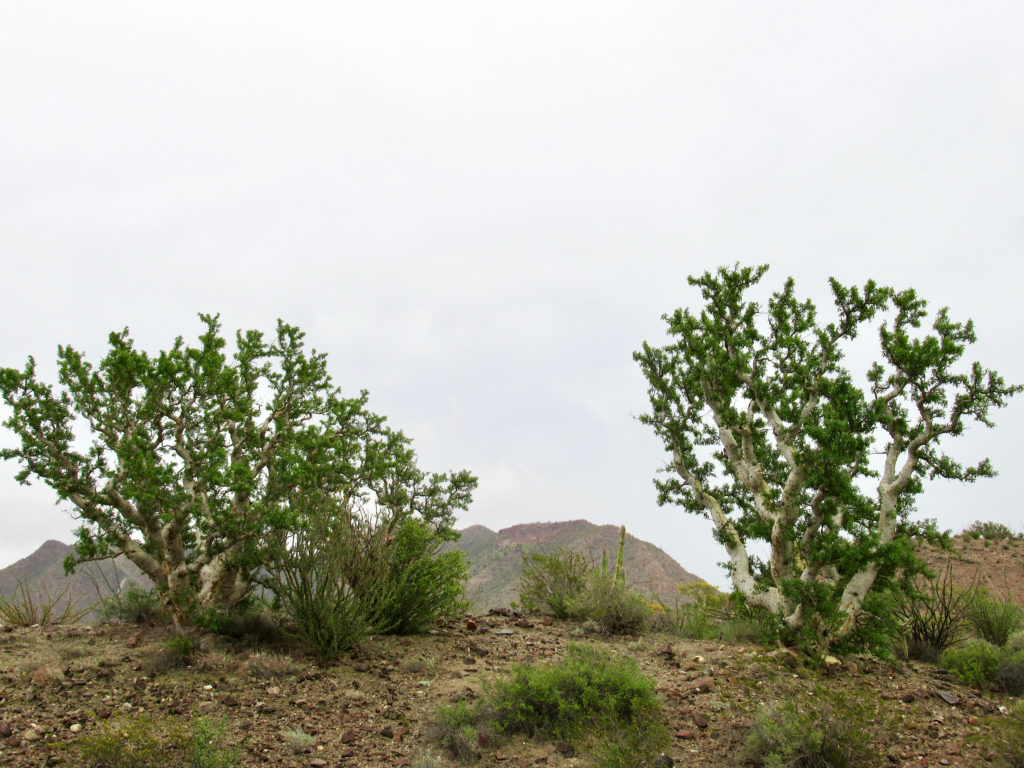
Cool fact
There are several different species of elephant trees in Baja. One of them belongs to the torchwood family. Other trees in this family are used to produce frankincense and myrrh. Apparently Bursera micropyllahas a unique smell as well. I need to get closer and catch that scent next time! The other common elephant tree on the peninsula (Pachycormus discolor) looks almost identical to the species above, but it belongs to the cashew family. Who knew?
Back to the Drive
We could spend days wandering through the boulders. But we need to make it to Bahia de los Angeles with plenty of daylight left to find a campsite and set up. Coming out of the rocks, the road heads straight across a flat, dry plain. Ahead is a “T” junction. There are no signs. The road is rough and narrow to the left and same to the right. RV travel in Baja is always an adventure! Looking at map, we think it is the junction before Laguna de Chapala. Nope. The dry plain we just passed is the lake! This is Highway #1 – undergoing a bit of construction.
Highway #1 in this part of the peninsula is narrow with no shoulders and lots of truck traffic. It requires concentration. Because of this we are extremely happy to reach to Bahia de los Angeles junction at Parador Punta Prieta. The PEMEX gas station at this corner has long closed, but there is a truck parked and a man selling gas out of barrels perched in the truck box. Any barrel will do with an empty tank, I guess.
Bahia de los Angeles
The paved road into Bahia de los Angeles is another half hour or so of pure delight – wide with little traffic and blooming Boojums everywhere! The Sonoran Desert shines brightly as we drive along the highland. Before long, we are dropping down towards the ocean. It is beautiful, if a bit stark and desolate after the prickly lushness of the high desert.
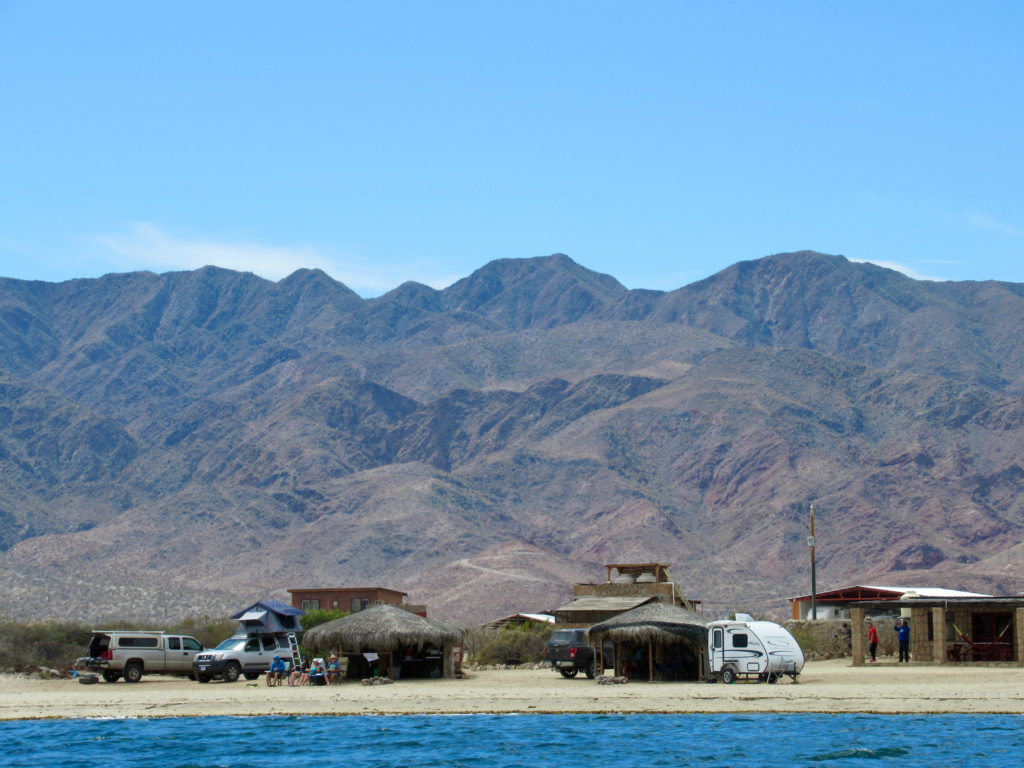
Passing not one, but two PEMEX gas stations on the edge of town, we drive two kilometers (1.2 mi) north of the roundabout to Archelon Camp (previously researched). An unserviced site with a palapa (thatch-roofed shelter) right on the waterfront cost $8 US per person per night. And – drumroll, please – there is toilet paper in the clean baños, soap and paper towels for washing hands by the sink and plenty of hot water for showers. To top it off, the restaurant serves excellent lattes and has Internet.
I’m not sure how busy Bahia de los Angeles is during the height of fishing season, but it is quiet and peaceful during our stay. There are still several campsites unoccupied. We walk the beach towards the lighthouse on the spit. Pelicans dive headfirst into the water to the right. Greater egrets wander tide pools. Herons fish. Buzzards feast on carrion. Osprey soar. Love this place already.
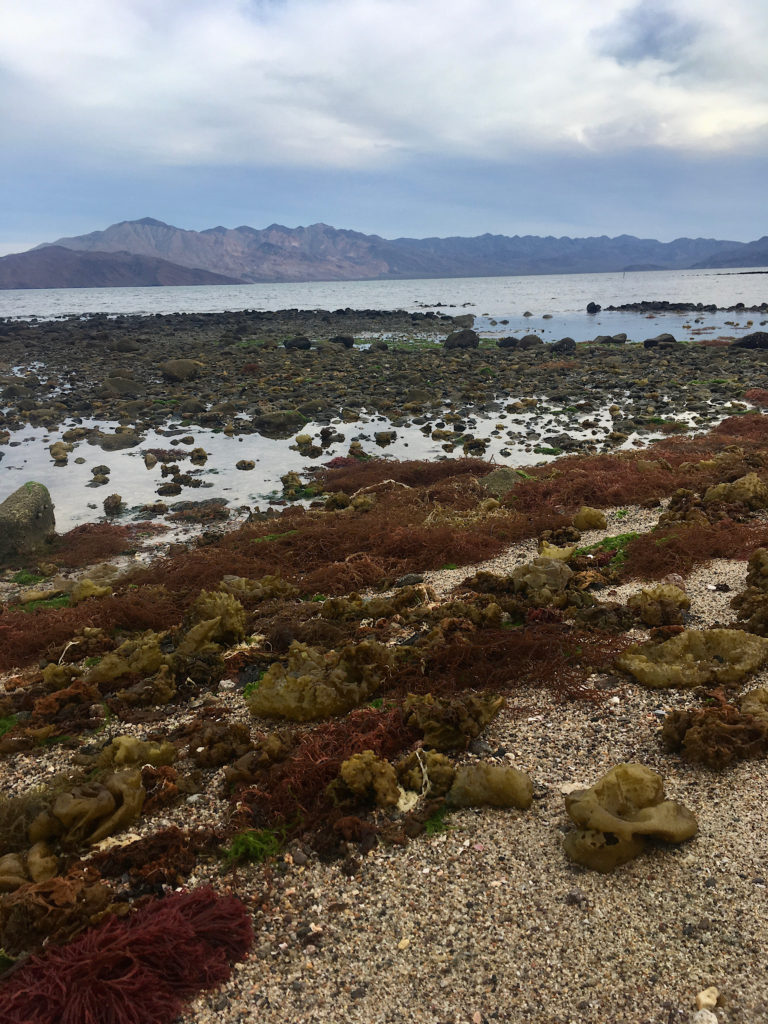
Heading back, our eyes are drawn to the islands dotting the bay. Isla el Borrego or Sheep Island. Wind Island or Isla la Ventana. Horse Head Island or Isla Cabeza de Caballo. These are just a few of the dozen or more islands in this wide bay off the Sea of Cortez. Grabbing the binoculars, we can barely make out a massive rock sign on the hillside at the far north end of the bay. It reads: Welcome a Gringo.
Day 2 in LA Bay
On our second day in the Bay of Angels, we inflate our kayak (love the convenience of our Aquaglide Klickitat) and paddle over to Isla Ventana. There is a light headwind, but the sky is clear. After a couple hours of fairly easy paddling, we pull up into small rocky pocket beach on the island – happy to get out and stretch.
The wind pushes us most of the way back. Brad fishes a little on the way back. He had four fish on, but didn’t keep anything. It took an hour and a half to cover the roughly four-kilometer (2.5 mi) distance between the island and shore.
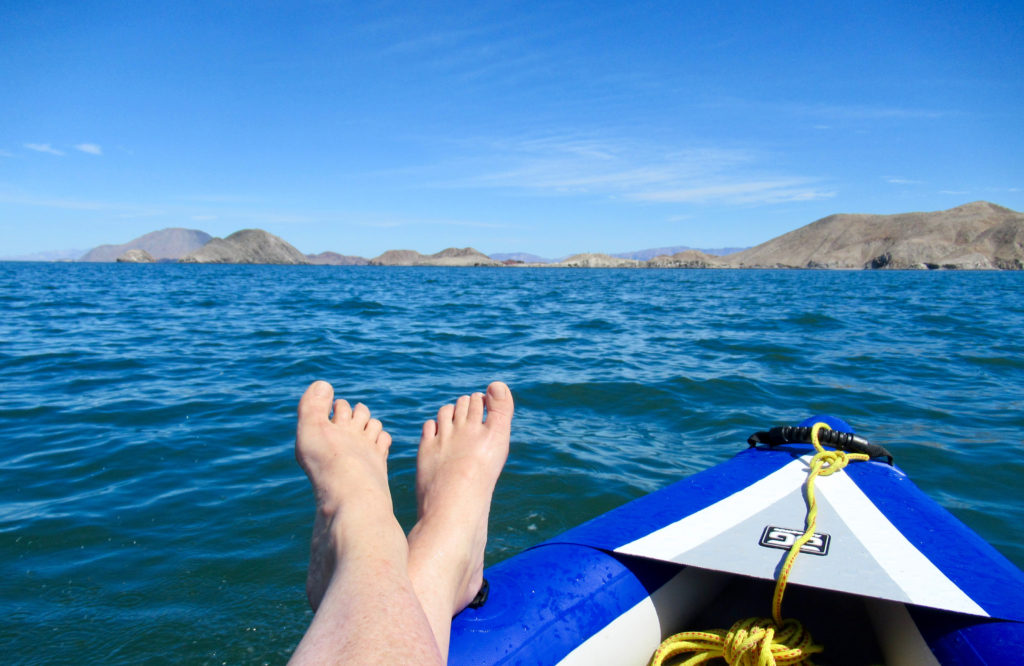
Word of Warning about Paddling in Bahia de los Angeles
Our friends visited Bahia de los Angeles once with their double ocean kayak. They were caught by the wind and made it back to shore, barely. They are avid paddlers and have been caught in high winds before. That being said, they won’t even begin to entertain paddling here again. Watch the weather and if you see clouds starting to form on the peaks of the mainland, get off the water. Fast.
Bahia de los Angeles: Day 3
The night before, we talked to Antonio at our camp about access for the rock art site at Montevido. He said the cave paintings were on a private ranch, but we could ask Ruben at Daggett’s (neighbouring camp) for the gate key. Sure enough, we found Ruben and he said we could go in no problem, but his son was up there with the water truck and had the key. We could still go in but just had to let his son know that we were there so that he wouldn’t lock us in!
Heading Out to Find Some Cave Paintings
Driving 20 kilometers (12.5 mi) from the traffic circle in Bahia de los Angeles on the highway back towards Parador Punta Prieta, we turn left (south) onto the Mission Borja road. Of course, this road is not paved. It is rough and feels like driving over a washboard the entire 3.5 kilometers (2.2 mi) to the smaller ranch road on our left.
Now this is where we have a bit of confusion. We think the ranch gate is 10 kilometers (6.2 mi) from the cave painting site (the site is actually 10 km from the Mission Borja road). Our plan is to drive up the ranch road to the gate, park and bike into the rock art.
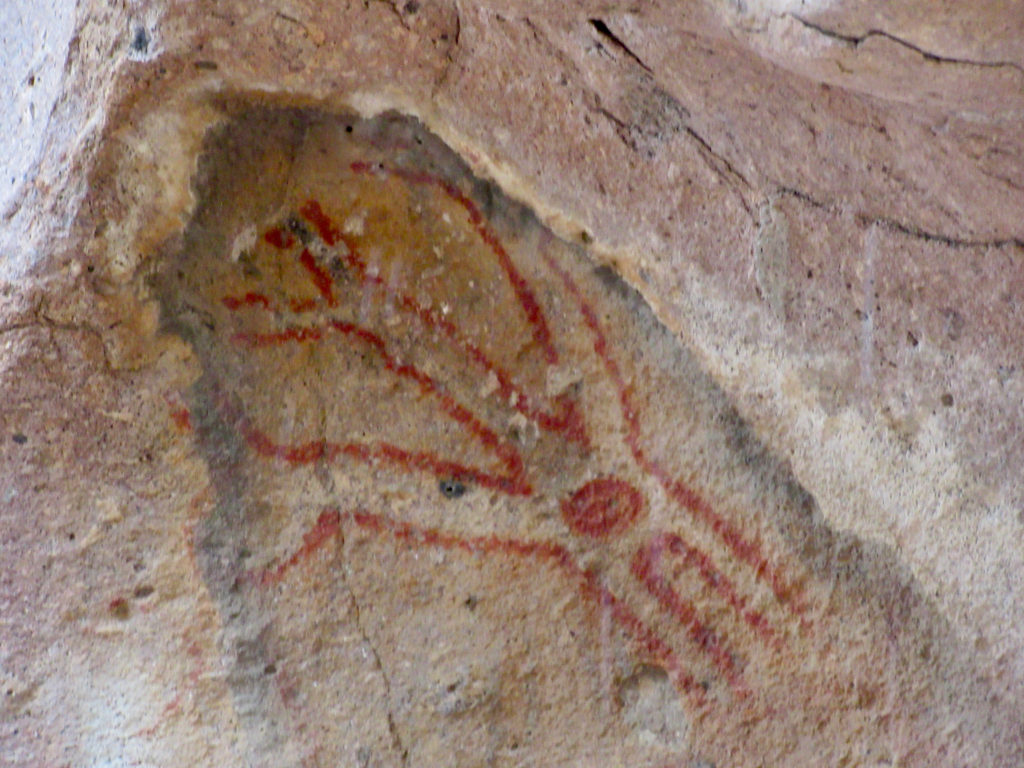
As we head up the narrow, sandy side road, I keep thinking that I hope we don’t meet any other vehicles coming the other way. Minutes later, a large, battered white Ford truck with a water tank in the back comes barreling down the road. He brakes, we brake and sit nose to nose for a second before we pull up out of the roadway onto a narrow ledge that we hope is free of cactus spines. As he pulls up beside us, I explain – in slow and careful Spanish – that we talked with Ruben and that we were hoping to see to the cave paintings. Smiling and nodding, he says he’ll keep the gate open for us.

Cycling Through a Boojum Forest
At this point, I’m done with driving our large pickup on this narrow road. I don’t care if it means we have to bike a little farther. We find a place large enough to turn around and park off the rutted roadway. Pulling out the bikes, we hop on and immediately relax. We are cycling through a Boojum and elephant tree forest. Everything is in full bloom. Birds sing. Sun shines. I can’t keep a grin off my face.
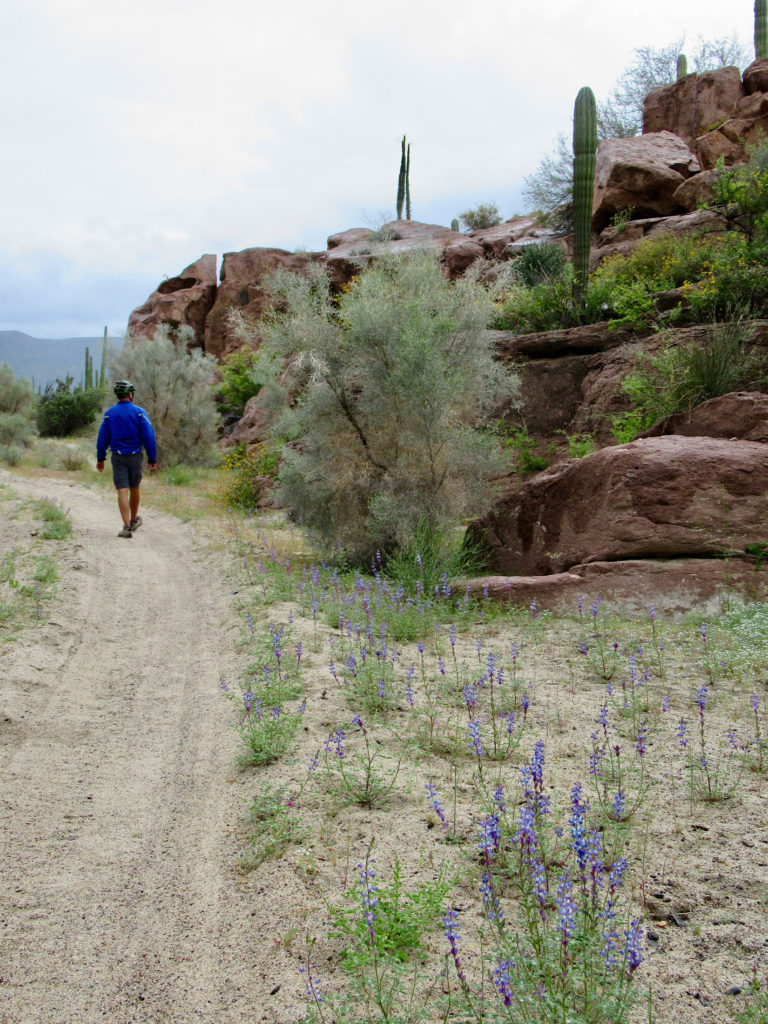
It is a slight – almost imperceptible – uphill ride. We reach the gate, cycle through and after another kilometre (0.6 mi), come to a junction. Because the tire tracks go right, which is where Ruben’s son was dropping off the water, we think the cave painting site must be to the left. Turns out we were right. After another easy 2.9 kilometers (1.8 mi), we arrive.
Montevido Cave Paintings
Ditching the bikes, we scramble up to the low, red cliffs and find faint paths that lead to painting after painting after painting. Clouds gather and rain falls lightly for a few minutes while we hide out under an overhang – still grinning ear to ear. This place is magical. Its spirit is strong and positive.
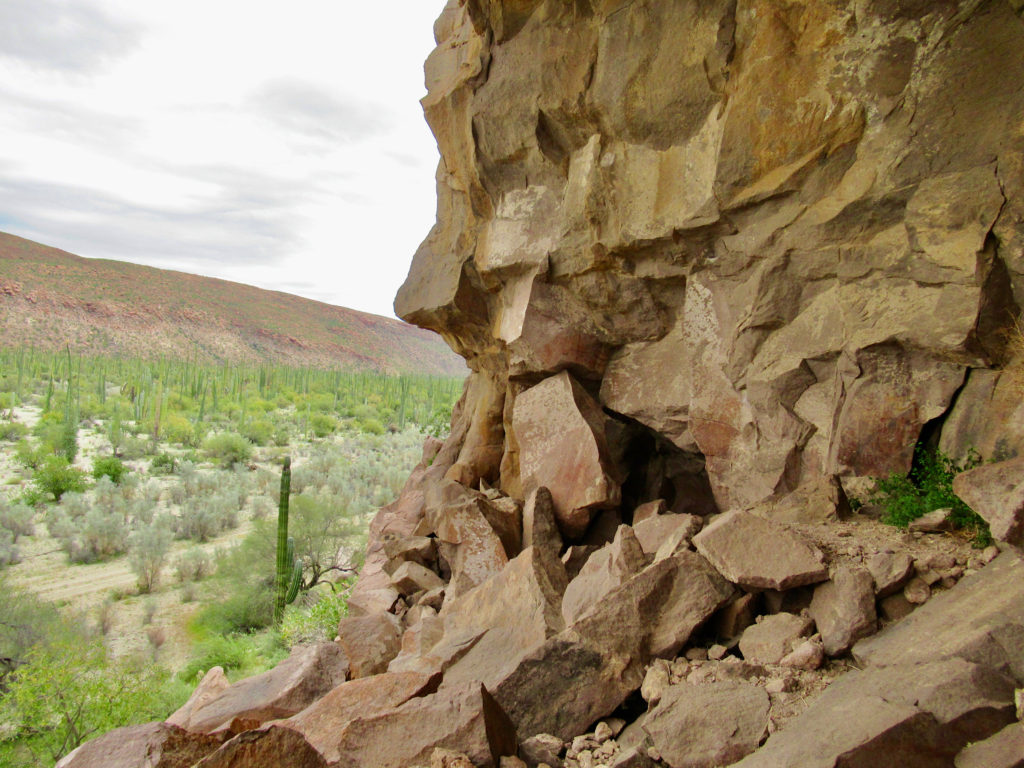
We couldn’t find much information about these cave paintings in our online research while travelling, but Harry Crosby’s book Cave Paintings of Baja California (an amazing resource we bought after our first Baja Cave Painting adventure) has some details on page 205:
“…The site consists of a 50-foot-high [ m] cliff of solid volcanic rock lined with small caves and shallow depressions… Many are painted and the school of art seen here is identical, or at least closely related, to that of nearby Arroyo Grande. However, these figures on the whole are somewhat larger and more skillfully painted. It is the finest and most extensive display of the abstract, symbolic type of prehistoric painting yet reported in Baja California…”
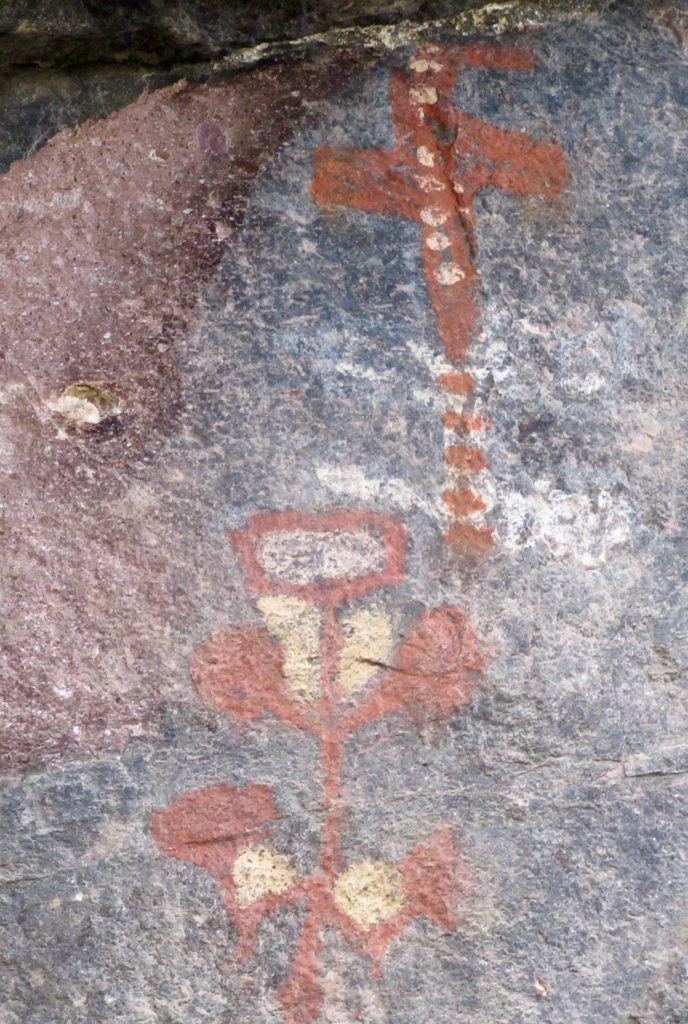
Once the rain passed it is time for us to leave – but we’ll be back one day to explore a little longer. Our ride back to the truck is fast and fun. We recommend parking on the Mission Borja road (good pullout near the cattleguard) and biking or hiking into the site – with permission, of course!
When You Go
- If you’re looking for other things to do in Bahia de los Angeles, visit the volunteer-run museum (open 10-1 pm.) It has a large grey whale skeleton, rows of seashells, pictures of cave paintings, leather work from ranch cowboys and little bit of mining history. They sell a bird checklist for Bahía de Los Angeles ($1 US).
- Inquire about a whale watching tour. While we didn’t have time on this trip, we’ll do this on the next one! Sperm whales can be found here in the winter months. Orcas can be seen throughout the year. Whale sharks visit in the summer and fall months. Ask at your camp or the museum for tour information.
Next Up: Part Three – Bahia Concepcion
PIN THIS POST FOR FUTURE REFERENCE!
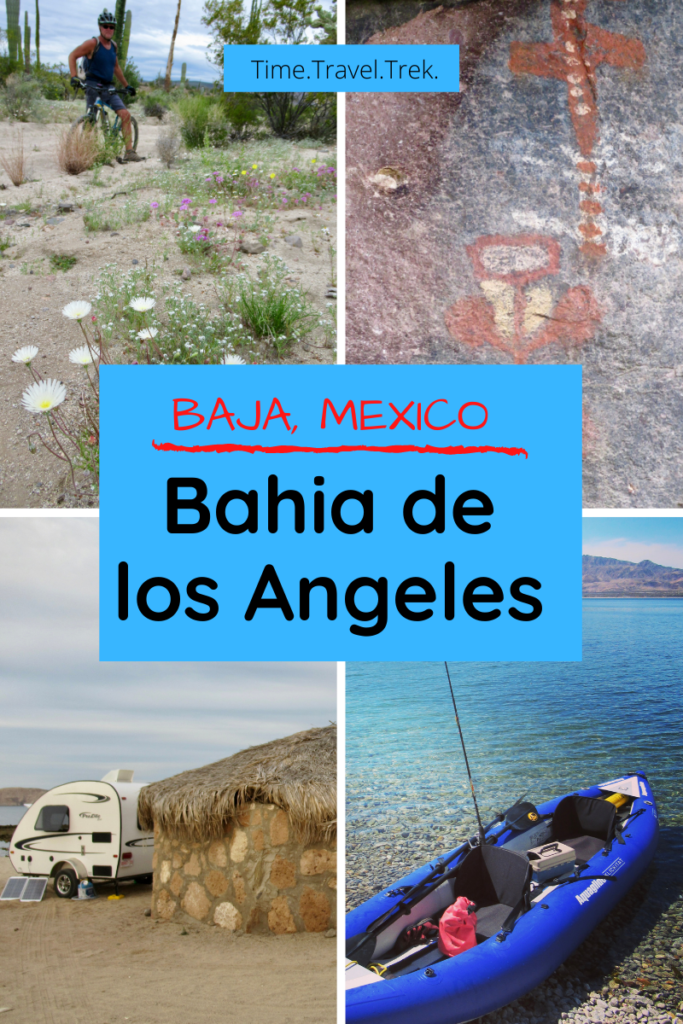
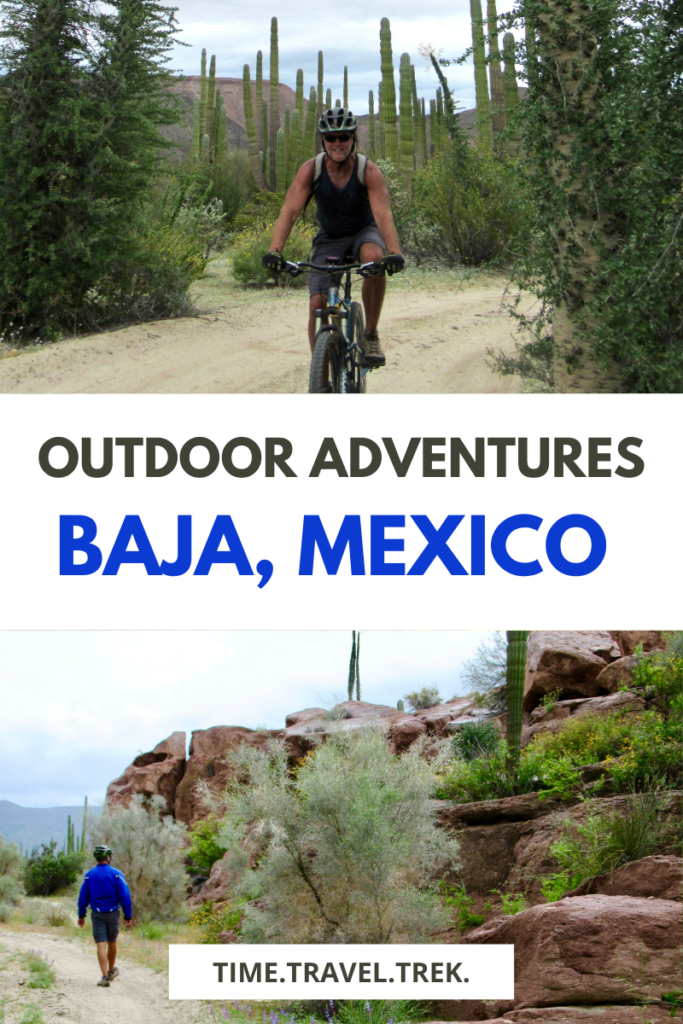





That would be so cool to see the cave art. And I am constantly in awe of how many crazy looking types of trees there are!
Seeing rock art and knowing it was painted or etched hundreds of years ago is a tangible connection to past. And trees… well… appreciating their diversity keeps us grounded!
A great account of your time here. I love the cave paintings.
My hope is that, more than just an account of my time here, this post provides inspiration and valuable information for others to explore Baja – cave paintings and all!
The Boojum trees look really cool! And funny. I didn’t know about their name history, so thank you for sharing that. Also, great tip about being careful in potentially high winds. That’s easy to forget! Glad your friends made it back safely.
Glad you learned something new – and I’m glad my friends made it back, too!
Baja is one of my most favorite places. When we were in college, we drove a van and all our sea kayaks from Colorado all the way down to La Paz, Baja. Camped along the way. Amazing times. Hope to go back someday with my husband. 🙂
I hope you get a chance to share this amazing place with your hubby one day soon!
nice to read something current about bola our favorite destination been there only three times last 8yrs ago must admit not really flora or fauna guy but I can tell by your writing share a love for this place with us its the people culture and food never took route south san felipe the trip is often the adventure especially with rv like to know about bridge and road conditions on highway 1 south
Lucky you to have been to BOLA (Bay of Los Angeles) three times. This was our first visit; it won’t be our last! Will be including a few more details about Hwy 1 road conditions south towards Loreto in my next post – Part 3!
Fun read Megan. Ann & I loved that side of the Baja. We spent a great week in Bahia de Los Angeles. Thanks for bringing back old memories.
Any time! I’m sure you and Ann have lots of great tips on places to explore in Baja.
This place looks so cool! I had never heard of it, so I am glad I came across your blog 🙂 Saving it for future trips.
I’m so glad you found Time.Travel.Trek. too! Do share your adventures when you eventually travel to Bahia de los Angeles.